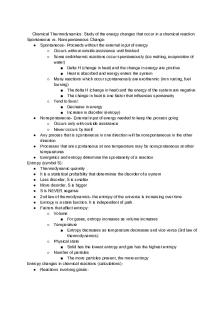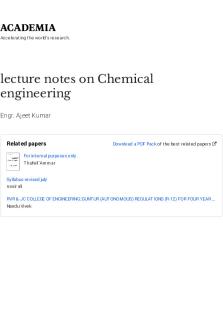Lecture Notes on Chemical Thermodynamics PDF

| Title | Lecture Notes on Chemical Thermodynamics |
|---|---|
| Author | Sophia Kirn |
| Course | Introd Chemistry Ii |
| Institution | Appalachian State University |
| Pages | 3 |
| File Size | 150.6 KB |
| File Type | |
| Total Downloads | 67 |
| Total Views | 151 |
Summary
Chemistry lecture notes on thermodynamics, spontaneity, Gibbs free energy, and entropy with equations, meanings of values, and graphs to help explain how to use the equations from Dr. Learn's course ...
Description
Chemical Thermodynamics: Study of the energy changes that occur in a chemical reaction Spontaneous vs. Nonspontaneous Change: ● Spontaneous- Proceeds without the external input of energy ○ Occurs without outside assistance until finished ○ Some endothermic reactions occur spontaneously (ice melting, evaporation of water) ■ Delta H (change in heat) and the change in energy are positive ■ Heat is absorbed and energy enters the system ○ Many reactions which occur spontaneously are exothermic (iron rusting, fuel burning) ■ The delta H (change in heat) and the energy of the system are negative ■ The change in heat is one factor that influences spontaneity ○ Tend to favor: ■ Decrease in energy ■ Increase in disorder (entropy) ● Nonspontaneous- External input of energy needed to keep the process going ○ Occurs only with outside assistance ○ Never occurs by itself ● Any process that is spontaneous in one direction will be nonspontaneous in the other direction ● Processes that are spontaneous at one temperature may be nonspontaneous at other temperatures ● Energetics and entropy determine the spontaneity of a reaction Entropy (symbol S): ● Thermodynamic quantity ● It is a statistical probability that determines the disorder of a system ● Less disorder, S is smaller ● More disorder, S is bigger ● S is NEVER negative ● 2nd law of thermodynamics- the entropy of the universe is increasing over time ● Entropy is a state function. It is independent of path. ● Factors that affect entropy: ○ Volume ■ For gases, entropy increases as volume increases ○ Temperature ■ Entropy decreases as temperature decreases and vice versa (3rd law of thermodynamics) ○ Physical state ■ Solid has the lowest entropy and gas has the highest entropy ○ Number of particles ■ The more particles present, the more entropy Entropy changes in chemical reactions (calculations): ● Reactions involving gases:
●
○ Calculate the change in the number of moles of gas, or the delta n of the gas ○ If the delta n of the gas is positive, then the delta S is positive Reactions without gases: ○ Calculate the number of moles of molecules ○ Delta n is equal to the n of the products minus the n of the reactants ○ If delta n is positive, entropy increases ○ More molecules mean more disorder
= [(sum S° products) – (sum S° reactants)] 1. Write and balance the reaction 2. Use a table of thermodynamic data of S to calculate ● ●
Delta H only varies slightly with temperature Delta S is highly dependent on temperature
Gibbs Free energy equation: ● ΔGrxn = ΔHrxn – T ΔSrxn ○ ΔHrxn is the heat of reaction ○ T is the temperature in Kelvin ○ ΔSrxn is the entropy of reaction ○ ΔGrxn is the Gibbs Free Energy ● ΔGrxn or Gibbs Free Energy, is the ultimate, final deciding factor as to whether a reaction will occur spontaneously, anywhere in the universe ○ When ΔGrxn = – #, the reaction is spontaneous. ○ When ΔGrxn = + #, the reaction is nonspontaneous. ○ When ΔGrxn = 0, the reaction is at equilibrium (has no tendency to go one way or the other)...
Similar Free PDFs

PDF Chemical Thermodynamics
- 173 Pages

Thermodynamics Lecture Notes
- 22 Pages

Thermodynamics - Lecture notes 1
- 8 Pages

Chemical Kinetics - Lecture notes 1
- 23 Pages
Popular Institutions
- Tinajero National High School - Annex
- Politeknik Caltex Riau
- Yokohama City University
- SGT University
- University of Al-Qadisiyah
- Divine Word College of Vigan
- Techniek College Rotterdam
- Universidade de Santiago
- Universiti Teknologi MARA Cawangan Johor Kampus Pasir Gudang
- Poltekkes Kemenkes Yogyakarta
- Baguio City National High School
- Colegio san marcos
- preparatoria uno
- Centro de Bachillerato Tecnológico Industrial y de Servicios No. 107
- Dalian Maritime University
- Quang Trung Secondary School
- Colegio Tecnológico en Informática
- Corporación Regional de Educación Superior
- Grupo CEDVA
- Dar Al Uloom University
- Centro de Estudios Preuniversitarios de la Universidad Nacional de Ingeniería
- 上智大学
- Aakash International School, Nuna Majara
- San Felipe Neri Catholic School
- Kang Chiao International School - New Taipei City
- Misamis Occidental National High School
- Institución Educativa Escuela Normal Juan Ladrilleros
- Kolehiyo ng Pantukan
- Batanes State College
- Instituto Continental
- Sekolah Menengah Kejuruan Kesehatan Kaltara (Tarakan)
- Colegio de La Inmaculada Concepcion - Cebu











